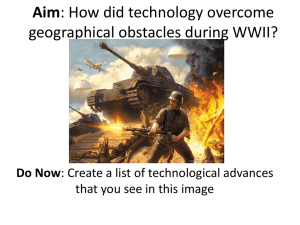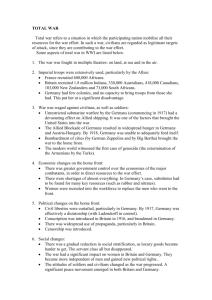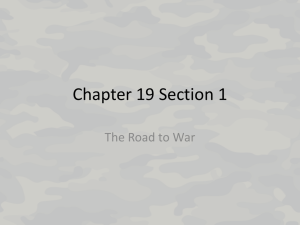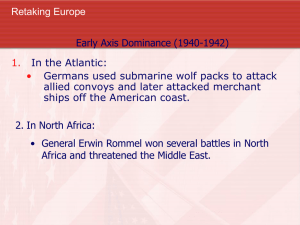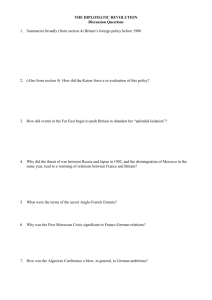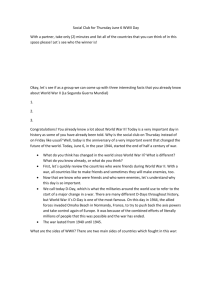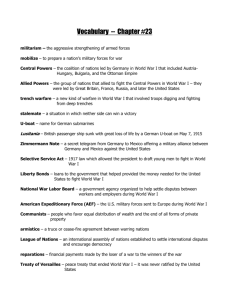Allies & Axis
advertisement
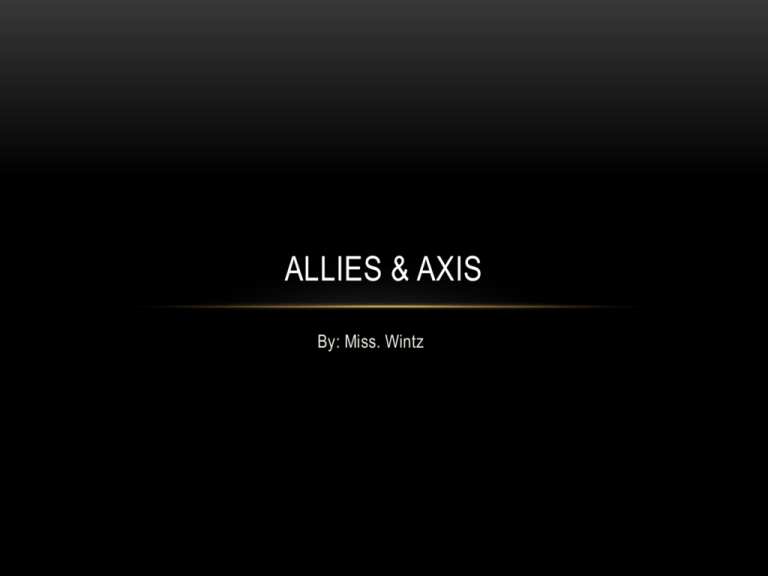
ALLIES & AXIS By: Miss. Wintz ESSENTIAL HISTORICAL QUESTIONS: • Who are the Allied & Axis powers? • What role did geography play during WWII? Did geography have an effect on the any part of war? THE ALLIED POWERS: • Countries that opposed the Axis powers during WWII. Sought to defeat the aggression of Germany, Italy, and Japan. • Generally governed by democracies. • Upheld religious tolerance and freedoms. • Although composed of many countries around the globe, the three major Allied powers included: • Great Britain • Russia • United States THE AXIS POWERS: • Countries that used forced to take territory they deemed to be rightfully theirs. • United under a general dislike of the Western world and its leaders. • Generally governed by dictators or totalitarian regimes. • Restricted religious and other freedoms. • Although many other countries joined, the three major Axis powers included: • • Germany • Italy • Japan Membership was fluid, meaning some countries entered and exited the pact during the war. • Russia agreed upon non-aggression with Germany in return for part of Poland, but ultimately switched to the Allied forces when Germany began a Russian invasion. STRATEGIC DECISIONS & TURNING POINTS DURING THE WAR: • • • The Allies invade Italy – July 1943 • U.S. and British troops invade Sicily • Eight days after the initial invasion, Allies had captured the Western half of the island and proceeded to take back the island from German troops in the East and South. • By August German troops evacuated the island. • With the success of the Allied Sicily campaign, Italy’s king placed Mussolini under arrest and publicly surrendered in September. D-Day Invasion – June 6, 1944 • 7,000 ships • 100,000 soldiers • 23,000 paratroopers • Five beach landings were made, code-named “Utah”, “Omaha”, “Gold”, “Sword”, and “Juno.” • After many causalities, the invasion was a success and Allied troops proceeded to move inland. General MacArthur’s return to the Philippines • Upon MacArthur’s return, the Allied powers attempted a two-pronged attack to push the Japanese back to their home island. • One fleet would island hop towards Japan while another fought to claim New-Guinea and re-take the Philippines. PAUSE FOR THOUGHT: • How did these decisions and events signal turning points in the war? List at least two reasons for each of the points listed. WAR CONFERENCES: Conference Date Participants Highlights MolotovRibbentrop Conference August 1939 Germany, Russia Hitler & Stalin sign non-aggression pact. Russia would not intervene if Poland is invaded. Atlantic Conference August 1941 Great Britain, United States Passed Atlantic Charter, creating a new general security system Casablanca Conference January 1943 Great Britain, United States Agreed to increase war in Pacific, increase pressure on Italy & invade Sicily, and insist on unconditional surrender from Germany. Tehran Conference November 1943 Great Britain, United States, Russia Allies agreed to launch two-front war. Russia would attack from East as soon as Great Britain & United States invaded France Yalta Conference February 1945 Great Britain, United States, Russia Russia agrees to help defeat Japan after war with Germany ends. Potsdam July 1945 Great Britain, United States, Allied powers agree Japan must surrender. Atomic bombs dropped PAUSE FOR THOUGHT: • What issues may have arisen from these war conferences? Identify issues for at least two of the conferences. THE WESTERN FRONT: • The territory at the center of Allied and Axis fighting. Encompassed Denmark, Norway, Luxemburg, Belgium, the Netherlands, Great Britain, France, and Western Germany. • Organized into two phases: • Phase 1 - 1940: • Invasion and fighting in Belgium, Netherlands, and France. • Air war with Great Britain that ended with the Battle of Britain. • Phase 2 - 1944: • Allied invasion of Normandy until the defeat of Germany in 1945. THE EASTERN FRONT: • After Germany’s defeat by Great Britain, the Axis powers shifted their focus to conquering Russia and Eastern Europe for new territory. • Germany waged war against Russia, Poland, and Norway. • Germany’s decision to go against their nonaggression pact with Russia and subsequent invasion will ultimately turn the tides of the war. • Germany’s push on Russia began in June 1941. • German troops claimed early victories through September. • November – December, Russia has the upper hand as cold weather causes difficulties for German troops. • Instead of continuing to spread across the entire Eastern front, German troops are focused on certain points. • Russian troops continue to push back and ultimately defeat the Germans by early 1945. THE PACIFIC THEATER: • War fought in the Pacific ocean and East Asia included: • • New Guinea, Philippines, the Solomon Islands, Borneo, and the Dutch East Indies. Began in December 1941 with the bombing of United States naval base located in Pearl Harbor. • The Japanese had retaliated on the Untied States for cutting off their oil supply in an attempt to prevent them from continuing war in the Pacific. • Japanese and Allied troops participated in island hopping as Allies attempted to drive back the Japanese to their home island. • War in the central Pacific was highly dangerous due to large coral reefs and shallow waters off the coasts of the islands. • The war ended with the atomic bombings of Hiroshima and Nagasaki. PAUSE FOR THOUGHT: • How might the geography in each theater of war (the Western front, the Eastern front, & the Pacific theater) pose problems for the Allied or Axis powers? List at least one problem that geography provided in each of these areas. FINAL THOUGHTS – ANSWER THESE QUESTIONS ON A SEPARATE PIECE OF PAPER: • On the blank map provided, color in the Allied powers discussed in the lesson with one color and the Axis powers with another color. With a pen or pencil, carefully label these countries. • On the back of the map answer the following question: What role did geography play during WWII? Did geography have an effect on the any part of war?

